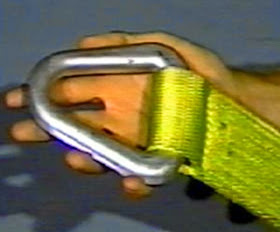SLINGS SAFETY
Rigging Equipment slings
The types of slings covered are those made from alloy steel chain, wire rope, metal mesh, natural or synthetic fiber rope (conventional three strand construction), and synthetic web (nylon, polyester, and polypropylene).
Sling Inspection
Each day before being used, the sling and all fastenings and attachments shall be inspected for damage or defects by a competent person designated by the employer. Additional inspections shall be performed during sling use, where service conditions warrant. Damaged or defective slings shall be immediately removed from service.
alloy steel chain slings
•Adapts to shape of the load
•Can damage by sudden shocks
•Best choice for hoisting very hot materials
•When one link in a chain fails, the load will come down.
•
Must have an affixed tag stating size, grade, rated capacity, and sling manufacturer
It must be marked with grade or manufacturer's mark
Inspection of Chain
Must be visually inspected prior to use.
Pay special attention to any stretching (any elongation from the original length.
The diameter of the worn chain link should be measured at the point of the greatest wear and compare with minimum allowable diameters in tables.
Chain Sling Wear Chart
Chain Size
(inches)
|
Minimum Allowable Chain Size (Inches)
|
Chain Size
(inches)
|
Minimum Allowable Chain Size (Inches)
|
¼
3/8
½
5/8
¾
7/8
|
15/64
19/64
25/64
31/64
19/32
45/64
|
1
1 1/8
1 ¼
1 3/8
1 ½
1 ¾
|
13/16
29/32
1
1 3/32
1 3/16
1 13/32
|
Wire Rope Slings
Strength — Function of size, grade, and construction. It must be sufficient to accommodate the maximum load that will be applied. The maximum load limit is determined by means of a multiplier. This multiplier is the number by which the ultimate strength of a wire rope is divided to determine the working load limit. Thus a wire rope sling with a strength of 10,000 pounds and a total working load of 2,000 pounds has a design factor (multiplier) of 5. New wire rope slings have a design factor of 5. As a sling suffers from the rigors of continued service, the design factor and the sling's ultimate strength are proportionately reduced.
Fatigue — A wire rope must have the ability to withstand repeated bending without the failure of the wires from fatigue. Failure is the result of the development of small cracks under repeated applications of bending loads. It occurs when ropes make small radius bends. The best way to prevent this is to use blocking or padding to increase the radius of the bend.
Abrasive Wear — The ability to withstand abrasion is determined by the size, number of wires, and construction of the rope. Smaller wires bend more readily and therefore offer greater flexibility but are less able to withstand abrasive wear. Conversely, larger wires of less flexible ropes are better able to withstand abrasion.
Abuse — Abuse will cause a wire rope sling to become unsafe long before any other factor. Abusing a wire rope sling can cause serious structural damage to the wire rope, such as kinking or bird caging which reduces the strength of the wire rope. (In bird caging, the wire rope strands are forcibly untwisted and become spread outward.) Therefore, in order to prolong the life of the sling and protect the lives of employees, the manufacturer's suggestion for safe and proper use of wire rope slings must be strictly adhered to.
Inspections
-Each day before use, the sling, all fastenings and attachments must be inspected by a competent person
-Additional inspections performed during use, where conditions warrant
-Damaged slings must be removed from service
Wire rope clips
Lubrication
Remove From Service When
6 broken wires in 1 lay
3 in one strand
Outer wire diameter worn 1/3 original diameter
Bird caged , crushed, kinked
Synthetic Web Sling Markings
•Mark or code to show:
Ø-Name or trademark of manufacturer
Ø-Rated capacities for the type of hitch
Ø
Synthetic Web Sling Stitching
The thread shall be in an even pattern and contain a sufficient number of stitches to develop the full breaking strength of the sling.
Synthetic Web Slings - Remove from Service
•Remove from service if any of these are present:
ØAcid or caustic burns
ØMelting or charring of any part
ØSnags, punctures, tears or cuts
ØBroken or worn stitches
ØDistortion of fittings
This sling should be removed from service. The red wear threads (red arrow) are showing through and there is obvious damage to the sling
NOTE:A 1000 lbs load is lifted using two true vertical hitches; the load is evenly divided between the two legs. However, go from a true vertical hitch to a non-vertical hitch, the load applied to the legs increase as the horizontal angle degrees.
























Sling Ropes are among the most common tools used in different industries for different purposes. Several industries need different equipment for the particular application and for that, there is a need for wire rope slings of various types which suit the equipment, industry, and application. Asahi Ropes is here to fullfill requirement of these types of industries.
ReplyDeleteThe individual wire strands subjected to a stranding process form a unique construct that allows flexibility tolerances within the wire strands, and to an extent within the entire wire sling rope.
ReplyDeleteWe specialize in designing and manufacturing of lifting beams and spreader beams asper customer requirements. Our Wire Rope Sling are Fully lubricated in manufacture and during supply.We make sure wire rope slings products perform consistently throughout its life span.
ReplyDelete